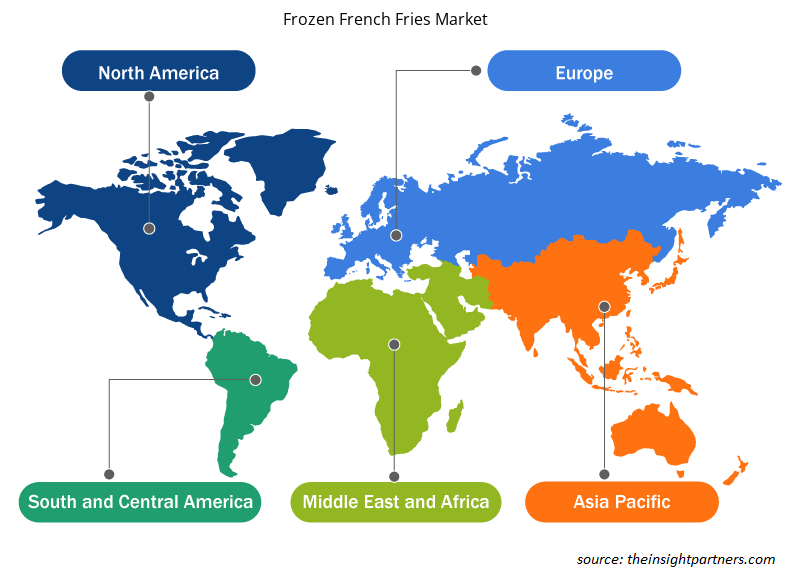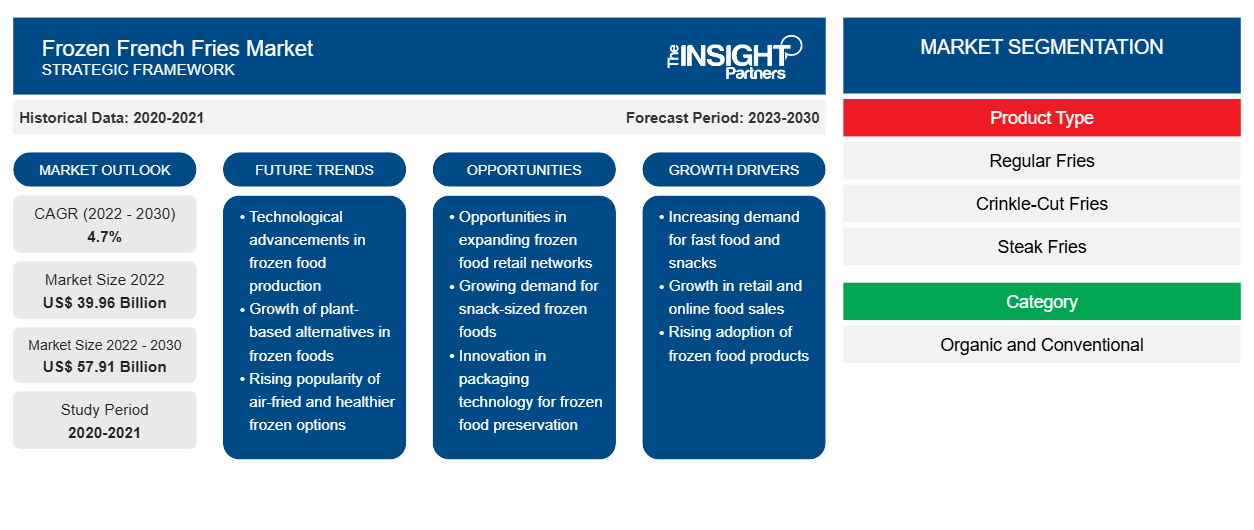[Rapporto di ricerca] Si prevede che il mercato delle patatine fritte surgelate crescerà da 39.955,11 milioni di dollari nel 2022 a 57.910,15 milioni di dollari entro il 2030; si prevede che registrerà un CAGR del 4,7% dal 2022 al 2030.
Approfondimenti di mercato e opinioni degli analisti:
Le patatine fritte surgelate sono fatte di patate e vengono servite calde. Le patatine fritte possono essere prodotte e servite in varie forme, come waffle, ricce e strisce sottili, e sono consumate come uno spuntino comodo. Sono servite con ketchup, salsa e altri. Le patatine fritte possono essere cotte al forno o fritte. Inoltre, i condimenti e gli aromi freschi e distintivi delle patatine fritte le aiutano a distinguersi dalla concorrenza e ad attrarre i clienti alla ricerca di esperienze culinarie inesplorate. I profili di gusto delle patatine fritte possono essere migliorati sperimentando varie erbe, spezie e miscele di condimenti, ampliando la selezione di alternative disponibili per soddisfare una più ampia varietà di scelte dei consumatori. La crescita del mercato globale delle patatine fritte surgelate è attribuita al numero crescente di aziende che forniscono servizi di consegna di cibo online, tra cui Food Panda, Swiggy, Uber Eats e altre. Hanno reso l'ordinazione di prodotti alimentari un compito facile e adatto per i consumatori. Inoltre, si prevede che i crescenti lanci di prodotti da parte dei principali partecipanti del settore spingeranno il mercato delle patatine fritte surgelate in avanti durante il periodo di previsione.
Fattori di crescita e sfide:
La catena del freddo, che consiste in pre-raffreddamento, stoccaggio refrigerato e trasporto refrigerato, è uno dei pilastri della catena di movimentazione post-raccolta. È considerata la spina dorsale di qualsiasi industria post-raccolta (sviluppata o in via di sviluppo) e un set essenziale di tecnologie per ridurre le perdite alimentari. La logistica della catena del freddo si è dimostrata fondamentale per qualsiasi paese che cerchi di aumentare la propria quota di mercato degli alimenti surgelati . L'infrastruttura della catena del freddo è aumentata in modo significativo negli ultimi anni. Ad esempio, secondo il rapporto dell'International Institute of Refrigeration (IIR) e della Global Cold Chain Alliance (GCCA), la capacità totale dei magazzini refrigerati a livello globale è aumentata a 719 milioni di metri cubi nel 2020, il 16,7% in più rispetto alla capacità segnalata nel 2018.
Inoltre, l'espansione della capacità della catena del freddo nei paesi emergenti varia da paese a paese. Nella maggior parte dei paesi, come Sudafrica, Messico e Kenya, la catena del freddo è concentrata nelle aree urbane e nei terminal dei trasporti, come gli aeroporti, dove possono essere situati gli esportatori. Inoltre, i principali fornitori di servizi di mercato migliorano costantemente le loro tecnologie per rimanere un passo avanti alla concorrenza e mantenere efficienza, integrità e sicurezza in tutto il mondo. Ad esempio, i fornitori hanno implementato la tecnologia Hazard Analysis and Critical Control Points (HACCP) e Radio Frequency Identification (RFID) per migliorare l'efficienza con spedizioni più piccole. Inoltre, stanno espandendo le loro flotte di veicoli refrigerati multi-scomparto per fornire servizi aggiuntivi ai consumatori. Pertanto, si prevede che i progressi nell'infrastruttura della catena del freddo offriranno opportunità redditizie per gli operatori del mercato delle patatine fritte surgelate, stimolando ulteriormente la crescita del mercato delle patatine fritte surgelate.
Personalizza questo report in base alle tue esigenze
Riceverai la personalizzazione gratuita di qualsiasi report, comprese parti di questo report, o analisi a livello nazionale, pacchetto dati Excel, oltre a usufruire di grandi offerte e sconti per start-up e università
-
Scopri le principali tendenze di mercato in questo rapporto.Questo campione GRATUITO includerà analisi di dati che spaziano dalle tendenze di mercato alle stime e alle previsioni.
Segmentazione e ambito del report:
Il "mercato globale delle patatine fritte surgelate" è segmentato in base al tipo di prodotto, alla categoria, all'utente finale e alla geografia. In base al tipo di prodotto, il mercato è segmentato in patatine normali, patatine fritte ondulate, patatine fritte da bistecca e altre. In base alla categoria, il mercato è diviso in biologico e convenzionale. In base all'utente finale, il mercato delle patatine fritte surgelate è segmentato in vendita al dettaglio e ristorazione. Il mercato delle patatine fritte surgelate, in base alla geografia, è segmentato in Nord America (Stati Uniti, Canada e Messico), Europa (Germania, Francia, Italia, Regno Unito, Russia e resto d'Europa), Asia Pacifico (Australia, Cina, Giappone, India, Corea del Sud e resto dell'Asia Pacifico), Medio Oriente e Africa (Sudafrica, Arabia Saudita, Emirati Arabi Uniti e resto di Medio Oriente e Africa) e Sud e Centro America (Brasile, Argentina e resto di Sud e Centro America).
Analisi segmentale:
In base al tipo di prodotto, il mercato delle patatine fritte surgelate è suddiviso in patatine normali, patatine fritte ondulate, patatine fritte da bistecca e altre. Il segmento delle patatine normali ha detenuto la quota maggiore del mercato delle patatine fritte surgelate nel 2022 e si prevede che registrerà un tasso di crescita significativo durante il periodo di previsione. Le patatine fritte normali nel mercato delle patatine fritte surgelate sono un contorno popolare nei fast food, nelle burger house e nelle case. Le patatine fritte normali sono più sottili delle patatine fritte da bistecca, solitamente tagliate in pezzi spessi tra 1/8 e 1/4 di pollice. Sono spesso salate e possono essere servite con ketchup, aceto, maionese, salsa di pomodoro o altre specialità locali.
Analisi regionale:
In base alla geografia, il mercato delle patatine fritte surgelate è suddiviso in cinque regioni chiave: Nord America, Europa, Asia Pacifico, Sud e Centro America e Medio Oriente e Africa. Il mercato globale delle patatine fritte surgelate è stato dominato dal Nord America e si stima che nel 2022 si aggirerà intorno ai 35.000 milioni di dollari. L'Europa è il secondo maggiore contributore, con una quota di mercato superiore al 25%. Il mercato delle patatine fritte surgelate in Nord America è suddiviso in Stati Uniti, Canada e Messico. Il mercato delle patatine fritte surgelate in Nord America è suddiviso in Stati Uniti, Canada e Messico. La regione è uno dei principali mercati per le patatine fritte surgelate grazie all'industria di trasformazione alimentare consolidata e alle crescenti tendenze di consumo da asporto, al consumo e in movimento. Molti importanti produttori di patatine fritte surgelate, come HJ Heinz Company, JR Simplot Company e McCain Foods Limited, operano attivamente nella regione. Queste aziende hanno ampliato la loro attività in tutta la regione e detengono una quota di mercato significativa. Hanno una rete di distribuzione diffusa nella regione, che li aiuta a soddisfare molti clienti. Quindi, tutti i fattori sopra menzionati spingono la crescita del mercato delle patatine fritte surgelate.
Sviluppi del settore e opportunità future:
Di seguito sono elencate le varie iniziative intraprese dai principali attori operanti nel mercato delle patatine fritte surgelate:
- A settembre 2020, Aviko BV ha acquisito uno stabilimento di patate in Germania dal gigante dei beni di consumo Unilever. Questo stabilimento trasforma le patate in prodotti di marca come purè, ravioli, gnocchi e snack istantanei.
- Nell'ottobre 2022, Lamb Weston Holdings, Inc. ha annunciato di aver stipulato un accordo per l'acquisto delle restanti quote azionarie della sua joint venture europea Meijer Frozen Foods BV per 763,58 milioni di dollari.
- A luglio 2021, Lamb Weston ha potenziato il suo stabilimento di patatine fritte in Idaho con un investimento di 415 milioni di dollari. Questa linea di lavorazione consentirà allo stabilimento di patatine fritte in Idaho di produrre più di 350 milioni di libbre di patatine fritte surgelate e altri prodotti a base di patate all'anno.
- A marzo 2023, McCain ha annunciato un investimento sostanziale a Coaldale, raddoppiando le dimensioni della sua struttura e la produzione a Coaldale, Alberta. L'investimento rifletterà la forte crescita aziendale di McCain.
Approfondimenti regionali sul mercato delle patatine fritte surgelate
Le tendenze regionali e i fattori che influenzano il mercato delle patatine fritte surgelate durante il periodo di previsione sono stati ampiamente spiegati dagli analisti di Insight Partners. Questa sezione discute anche i segmenti e la geografia del mercato delle patatine fritte surgelate in Nord America, Europa, Asia Pacifico, Medio Oriente e Africa e America meridionale e centrale.

- Ottieni i dati specifici regionali per il mercato delle patatine fritte surgelate
Ambito del rapporto sul mercato delle patatine fritte surgelate
| Attributo del report | Dettagli |
|---|---|
| Dimensioni del mercato nel 2022 | 39,96 miliardi di dollari USA |
| Dimensioni del mercato entro il 2030 | 57,91 miliardi di dollari USA |
| CAGR globale (2022-2030) | 4,7% |
| Dati storici | 2020-2021 |
| Periodo di previsione | 2023-2030 |
| Segmenti coperti |
Per tipo di prodotto
|
| Regioni e Paesi coperti |
America del Nord
|
| Leader di mercato e profili aziendali chiave |
|
Densità dei player del mercato delle patatine fritte surgelate: comprendere il suo impatto sulle dinamiche aziendali
Il mercato delle patatine fritte surgelate sta crescendo rapidamente, spinto dalla crescente domanda degli utenti finali dovuta a fattori quali l'evoluzione delle preferenze dei consumatori, i progressi tecnologici e una maggiore consapevolezza dei benefici del prodotto. Con l'aumento della domanda, le aziende stanno ampliando la propria offerta, innovando per soddisfare le esigenze dei consumatori e capitalizzando sulle tendenze emergenti, il che alimenta ulteriormente la crescita del mercato.
La densità degli operatori di mercato si riferisce alla distribuzione di aziende o società che operano in un particolare mercato o settore. Indica quanti concorrenti (operatori di mercato) sono presenti in un dato spazio di mercato in relazione alle sue dimensioni o al valore di mercato totale.
Le principali aziende che operano nel mercato delle patatine fritte surgelate sono:
- Azienda di patate di Bart
- Aviko BV
- Agristo NV.
- Società quotata in borsa Lamb Weston Inc.
- McCain
Disclaimer : le aziende elencate sopra non sono classificate secondo un ordine particolare.

- Ottieni una panoramica dei principali attori del mercato delle patatine fritte surgelate
Impatto del COVID-19:
La pandemia di COVID-19 ha colpito economie e settori in vari paesi. I lockdown, i divieti di viaggio e le chiusure delle attività nei principali paesi del Nord America, Europa, Asia Pacifico (APAC), Sud e Centro America (SAM) e Medio Oriente e Africa (MEA) hanno influenzato negativamente la crescita di vari settori, tra cui quello alimentare e delle bevande. La chiusura delle unità produttive ha disturbato le catene di fornitura globali, le attività di produzione, i programmi di consegna e le vendite di vari prodotti essenziali e non essenziali. Diverse aziende hanno annunciato possibili ritardi nelle consegne dei prodotti e un crollo delle vendite future dei loro prodotti nel 2020. Inoltre, i divieti imposti da vari governi in Europa, Asia e Nord America sui viaggi internazionali hanno costretto le aziende a sospendere temporaneamente i loro piani di collaborazione e partnership.
Scenario competitivo e aziende chiave:
Bart's Potato Company, Aviko BV, Agristo NV., Lamb Weston Holdings Inc, McCain, Farm Frites International BV, Rairandev Golden Fries Pty Ltd, Himalaya Food International Ltd, JR Simplot Company e The Kraft Heinz Co sono tra i principali attori che operano nel mercato globale delle patatine fritte surgelate. Questi produttori di patatine fritte surgelate offrono opzioni di snack all'avanguardia con forme innovative per offrire un'esperienza superiore ai consumatori.
- Analisi storica (2 anni), anno base, previsione (7 anni) con CAGR
- Analisi PEST e SWOT
- Valore/volume delle dimensioni del mercato - Globale, Regionale, Nazionale
- Industria e panorama competitivo
- Set di dati Excel
Report recenti
Rapporti correlati
Testimonianze
Motivo dell'acquisto
- Processo decisionale informato
- Comprensione delle dinamiche di mercato
- Analisi competitiva
- Analisi dei clienti
- Previsioni di mercato
- Mitigazione del rischio
- Pianificazione strategica
- Giustificazione degli investimenti
- Identificazione dei mercati emergenti
- Miglioramento delle strategie di marketing
- Aumento dell'efficienza operativa
- Allineamento alle tendenze normative























 Ottieni un campione gratuito per - Mercato delle patatine fritte surgelate
Ottieni un campione gratuito per - Mercato delle patatine fritte surgelate